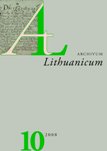Jono Bretkūno Postilės (1591) teksto istorija: perikopių redagavimo šaltiniai
The story of pericope texts of Jonas Bretkūnas Postilla (1591): Sources of editing
Author(s): Ona AleknavičienėSubject(s): Christian Theology and Religion, Theoretical Linguistics, Baltic Languages, 16th Century, Biblical studies, Translation Studies
Published by: Lietuvių Kalbos Institutas
Keywords: Jonas Bretkūnas Postilla; gospels; 16th century; letters; liturgical texts;
Summary/Abstract: In this article I make an effort to determine in what way and based on what Jonas Bretkūnas edited the text of the Bible (pericopes) that he took from Baltramiejus Vilentas’s Gospels and Letters (Evangelijos bei Epistolos, 1579; EE) and inserted before the sermons in his own Postilla (1591; BP). I analyze separately the corrections of the initial lines of pericopes. All this research is important for the understanding of Bretkūnas’s work with the process of preparing the text, and for the assessment of Bretkūnas’s attitudes towards the Bible text. My analysis leads to the following conclusions: (1) A fter Jonas Bretkūnas took pericopes from Baltramiejus Vilentas’s Gospels and Letters for his Postilla, he edited them in compliance with Martin Luther’s Bible (1546 or later editions; LB). Most of the additions, omissions, and changes that Bretkūnas made in BP are proof of a conscious and purposeful comparison with LB. (2) B retkūnas’s BP presented one more version of Lithuanian liturgical texts to society and added to the variety of Lithuanian Bible texts available at the time. The main direction of Bretkūnas’s work was to establish Luther’s Bible. Bretkūnas edited the places in the text that Vilentas had earlier translated from the Vulgate and from the Greek New Testament, and in this way diminished the number of passages of the text corresponding to those originals (he distanced his text farther from the Vulgate which was canonized by the Catholic Church). (3) Because of the conscious and purposeful changes, the texts of BP pericopes must be considered as a new edition of EE texts. Bretkūnas critically assessed every pericope of EE, he matched the translation to LB and more seldom to the Greek New Testament, and he searched for the optimal means to express the content of the original. Bretkūnas performed a philological analysis of Vilentas’s translation. Bretkūnas’s pericopes reflect not only Vilentas’s but also Bretkūnas’s mentality, knowledge of exegesis and ability to write well. (4) Similar parallel passages in BP and Bretkūnas’s Bible (BNT) are most often determined by the availability of synonyms in the Lithuanian language and should not be considered a result of BNT influence. I did not find any proof that Bretkūnas used other Lithuanian texts with pericopes from the Bible in editing the excerpts taken from EE. It was Vilentas who kept more to the traditional text. (5) Bretkūnas’s correction of the initial lines of the pericopes was evidently determined not by the translation originals but by the concept of the Bible excerpt as a liturgical text. This attests to the pragmatic competence of Bretkūnas.
Journal: Archivum Lithuanicum
- Issue Year: 2008
- Issue No: 10
- Page Range: 29-60
- Page Count: 32
- Language: Lithuanian

